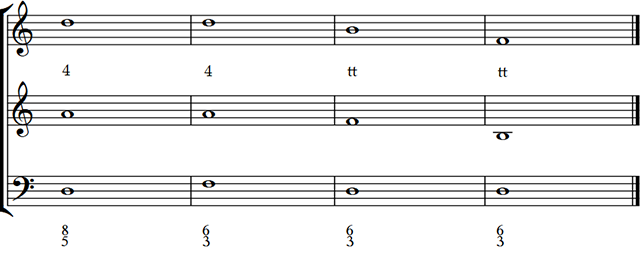Modal Counterpoint in Three, Four & Five Parts
Three Part Counterpoint
Thus far we have dealt with species counterpoint in two parts. When a third part is added there is a bit more harmonic interest and complexity. Complete triads are possible, but the three parts may not always include the 5th of the triad, and it is often replaced by a doubled root along with the third. A voicing with two roots and a fifth is not uncommon.
There are now three combinations of intervals to be considered between the top, middle, and bottom parts. These are: 1) top and bottom, 2) middle and top, and 3) middle and bottom parts. When analyzing or writing in three parts, it remains a good practice to write the number of the interval above the bottom to the upper voices, along with the interval from middle to top. The consonant intervals are still used between voices, but there is a new dissonance allowed. This is the P4th or tritone between the upper parts when the third is in the bass, or when the root is doubled with a fifth in the middle. Various types of internal cadences are common, including authentic, plagal, and deceptive. Modal cadences were also used through the 16th century, particularly Phrygian.

Three-part voicings with a Perfect 4th or Tritone on top.
In textures with three parts, another harmonic structure is the “consonant fourth.” This happens when the upper part is a 4th species suspension against the bass. There is also a case where the upper parts are both consonant with the bass, but dissonant with each other. Over a suspension, a 6/5 chord creates a momentary dissonance of a second between upper voices. Both of these are illustrated in the example below.

Three-part voice leading with the 6/5 and the consonant fourth.
There is more rhythmic interest when three parts are used, and the practice of moving one or two parts with shorter note values against a part with longer note values is usually observed. This leads to independence between the parts, and more varied rhythms.
Compared to the sacred music in the Renaissance, the secular three-part music utilized shorter phrases in a more syllabic style, and more tonal cadences. Texturally, the music is florid counterpoint except for sections that may be homorhythmic in texture, like a chorale. These sections are referred to as the “familiar style,” and provide relief from the constant polyphony.
The instrumental music in three parts compared to the vocal music had a few different features. Pieces for instruments were usually sectional, with points of imitation, but more motivic and freer in the use of dissonance than vocal music. The fantasia, ricercar, and canzona all showed constant developmental treatment of thematic ideas.
Examine the compositions in three parts among the Activities, looking for the features mentioned above.
Four Part Counterpoint
With three voices the complete triad could be presented. In four voices, the question of which triad member to double must be addressed if all four voices are singing simultaneously. The most stable, and commonly used distribution of parts is with the root in the bass and doubled in another voice. Writing for quartets allows even more opportunities for individual voices to have notes of varied durations. Composers achieve clarity in four-part counterpoint by using longer note values in some parts while other parts are more active, and using rests judiciously.
Counterpoint in Five or More Parts
With so many parts moving at once, a thick texture can result and independent lines can become obscured. However, a satisfactory effect is accomplished with wider spacing between parts, and controlled activity while voices imitate one another. Changes in texture are used to vary the density and lend a sense of forward motion, while pairs of voices work together in duets. See the Orlando Gibbons (1583-1625) madrigal in the Activities for a vocal example. There are numerous examples in the instrumental music of Giovanni Gabrieli (1557-1613) as well.
Activities
Counterpoint Analysis
Listen to and analyze some of the pieces below, included in the Counterpoint Examples: 16th & 17th Centuries. Identify these parameters to discover features and relationships in the music:
- Texture: Number of parts, voices, instruments, their independence
- Melody: Stepwise or leaping; similar, oblique or contrary motion
- Harmony: Modes, keys, pitch centers, modulations, cadences
- Intervals: Numerical analysis of harmonic intervals between parts
- Structure: Themes, phrases, sections, points of imitation, episodes
- Rhythm: Tempo, meter, duration, proportions, or based on a text
- Form: Canon, round, fugue, invention, chorale prelude, trio sonata
- Personal Observations: Unique and striking features, impressions
Pieces for Analysis
Three-Part Examples
Four-Part Examples
Giovanni Pierluigi da Palestrina (1525-1594)
Missa Brevis Kyrie (4-part Motet) [YouTube]
Five-Part Examples
Orlando Gibbons (1583-1625)
The Silver Swan (5-part Madrigal) [YouTube]
